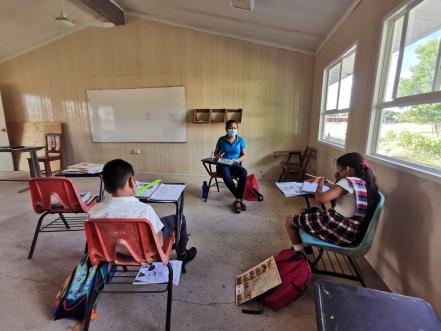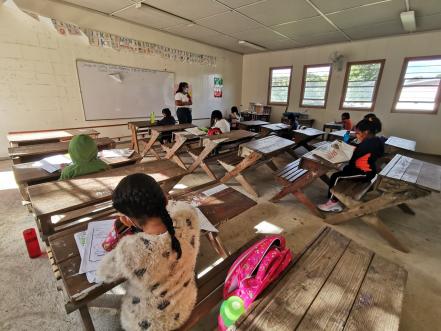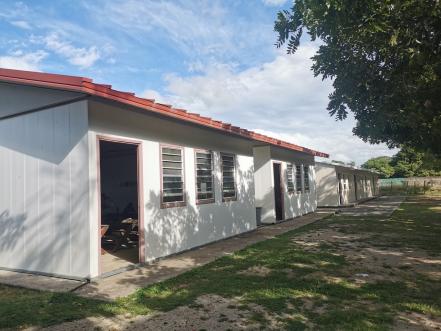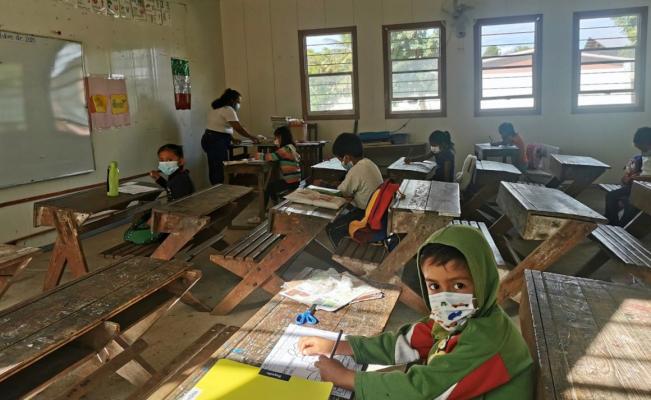Chicapa de Castro, Oax.— The six temporary plastic classrooms from this school sthey warm up after noon, which makes teaching difficult for the few children who attend face-to-face classes, but the teachers and parents of the Miguel Hidalgo elementary school in Chicapa de Castro prefer the heat to continue with the deficient online education.
For more than a year, the seven teachers did everything they could to comply with the classes via Zoom and WhatsApp with their 132 students, but the bad internet signal in this Juchitán agency made this task difficult.
Although they sought to remedy the situation with the implementation of strategies that did not put them or the students at risk, such as individual classes at home for children with problems, academic progress was limited.
“It was a very difficult year for everyone, because one of the main obstacles to reaching 100% of the content was connectivity, and in the population the internet signal is very bad.
“For example, of my 27 students, 10 of them could not connect. I had to manage to regularize them in my house or in each one’s house; it was also tiring and exhausting. Faced with this critical situation, we decided to return, even if it was in the temporary classrooms ”, explains the fourth grade teacher, Virginia Ramírez Ramos.
Lee: In Oaxaca, there is a generation of children who do not know the classrooms
Another problem they observed during a year was that many of the parents did not have the necessary knowledge to guide and guide their children from home following the instructions of the teachers.

In addition, the group that faced the most difficulties during online classes, according to the institution’s teachers, was the first grade; Since by not receiving face-to-face classes at the preschool level, the psychomotor problems increased when they reached primary school.
“We have two months of two-hour face-to-face classes for two days a week, and I can say that the most difficult thing to solve are the motor problems that children of this level drag, because it makes it difficult for them to work with something as simple as scissors, activity that they develop in preschool and did not have it; so this situation has to be attended to in person, there is no other way ”, says the first grade teacher, Doraceli Sánchez.
These problems detected by the teachers led to resume hybrid classes, two days in classrooms, two days online and one day giving online and face-to-face counseling. For the physical classes, they returned under a strict security protocol with the approval of the parents and the agency authorities.
“The children are only in the classroom for two hours, all the time wearing masks. Everyone brings their antibacterial gel, there is no recess and a sanitizer is sprayed upon entering.
“At the end of the classes, each parent picks up their child and takes him straight home. We do not allow children to move in groups because there is a risk that they deviate from the path to their homes and become infected at some point, so the responsibility of moving them safely falls on the parents ”, comments the director Ahuitzotl Jiménez Pérez.
The plastic classrooms were built four years ago by the state government, as a provisional response to the destruction of the school, after the earthquake that occurred on September 7, 2017.

Its flaws are already noticeable: part of the roof supports are beginning to come off and the teachers fear that it will not withstand the strong winds.
“The classrooms were given to us while we waited for the reconstruction of the six classrooms that fell in the earthquake. It is not supposed to be more than a year, but we have been four years and the new classrooms are still not delivered.
“These prefabricated modules began to show failures from the first months, in the first year. With the first winds, one of the rooms was raised, so suddenly a gust lifted it. The children were scared and the teachers fastened it with nails again. They will not last much longer, but we have no choice in this return to school, we return to what we had before, ”he highlights.
Therefore, authorities and teachers demand that the Oaxacan Institute of Physical Education Infrastructure Constructor (Iocifed) finish the reconstruction of the six classrooms that are already 70% complete, but whose work is suspended due to the lack of resources from the Natural Disaster Fund ( Fonden).
The institution’s situation worsened after Constructora Salcedo, to which the works had been assigned, defrauded them with the money assigned to them by the Fonden, since it only built 30% of the buildings and disappeared.

Later, the work was taken up by the Robles y Gopar company, which promised to deliver the school in 95 days, but did not comply either, arguing that Iocifed did not pay it.
According to the report delivered by Adolfo Maldonado, head of Iocifed, to the State Congress, on the Isthmus of Tehuantepec, there is a 98% progress in the reconstruction of 282 schools damaged by the earthquakes, without specifying how many students continue to be abandoned in classrooms. such as the Miguel Hidalgo primary school, which is adapting to the new normal with the same lags as before the health crisis.
– .


